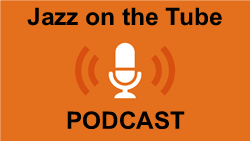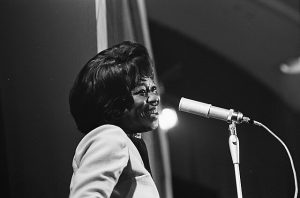Ella Fitzgerald
Jazz On The Tube Radio
Tribute
Ella Fitzgerald
Ella Jane Fitzgerald was born on April 25, 1917 in Newport News, Virginia and moved with her mother to live in Yonkers, New York at a young age. As a young girl Ella’s desire was to be a dancer though she did love listening to recordings of Jazz singers including Louis Armstrong, Bing Crosby and The Boswell Sisters and loved Connee Boswell. Ella’s mother passed in 1932 as well as her step-father shortly after and this led to a rough patch in her life with Ella working odd jobs and living in undesirable situations. Fitzgerald caught a break though in 1934 as her name was drawn in a contest to sing at Amateur Night at the Apollo. Ella originally planned to dance at the Apollo but after seeing the Edwards Sisters dance right before she was slated to perform she changed her mind at the last minute and decided to sing the tune ‘Judy’. Fitzgerald won first place and caught the eye of Benny Carter who played in the Apollo band and began introducing her to people in the business. Ella continued entering and winning contests and in 1935 she won the chance to perform with the Tiny Bradshaw band at the Harlem Opera House for a week. This led to her being discovered by drummer Chick Webb and he hired Ella to join his band for $12.50 a week.
Ella performed with Chick Webb’s band recording several hits including ‘A-Tisket, A-Tasket’ which became a hit and drew national attention. Chick passed away in 1939 and the band was renamed Ella Fitzgerald and her Famous Orchestra and they would record more than 150 sides during her time with the group. In 1942 Ella left the band to begin her solo career and signed with Decca and Norman Granz became her manager. Fitzgerald toured with Jazz at the Philharmonic as well as recording with the Ink Spots, Louis Jordan and the Delta Rhythm Boys. It was during this time period that Jazz began to move into its Bebop phase and Ella would not be left behind. Fitzgerald worked with Dizzy Gillespie and started taking scat solos trying to emulate the horn players. In 1945 she released a scat version of the tune ‘Flying Home’ and took Jazz scat, first made popular by Louis Armstrong, to the next level. She followed that up with a recording of ‘Oh, Lady Be Good’ in 1947 that continued to amaze fans and change the perspective of how a vocalist could interact with the band in Jazz.
In 1955 Ella joined Verve records, which was run by Norman Granz and he began to take her career in a new direction. While Fitzgerald had begun almost exclusively singing bebop, Granz wanted to show off that voice some more and began recording her songbook series. Ella began with the Cole Porter Songbook, followed by the Duke Ellington Songbook and would also record albums focusing on the music of Gershwin as well as Antonio Carlos Jobim. This series is often looked back upon as Ella’s greatest work and brought her much success. Other notable events from this period include Marilyn Monroe helping Ella become the first African-American to perform at the club Mocambo and Ella’s albums ‘Ella in Rome’, ‘Ella in Berlin’ and ‘Twelve Nights in Hollywood’. Granz sold Verve Records in 1967 and Ella recorded some different material for a few years including a Christmas album and an album titled ‘Misty’ that featured country and western music. But in 1972 Granz formed Pablo Records and brought Ella back and she continued to have success working with Granz with the albums ‘Jazz at Santa Monica Civic’ in 1972 and ‘Ella in London’ in 1974 with Joe Pass, Tommy Flannigan, Keter Betts and Bobby Durham.
Ella recorded over twenty albums on Pablo Records before her health began to decline in 1991. Fitzgerald’s last record was released in ’91 as well as the last of her twenty six performances at Carnegie Hall. Ella Fitzgerald passed away in 1996. Ella recorded more than 200 albums in her career and just a few of the honors she received include thirteen Grammy awards, Kennedy Center for Performing Arts’ Medal of Honor Award, The Recording Academy Lifetime Achievement Award, the first ASCAP Award in recognition of an artist, four honorary doctorates, the NAACP Award for lifetime achievement, a star on the Hollywood Walk of Fame and a commemorative stamp from the U.S. Postal Service. Ella leaves a legacy of being one the greatest if not the best Jazz singer in history and expanded the perception of what a Jazz singer should be. Every modern jazz singer coming up today now looks to Ella as the standard of the level of mastery expected as a vocalist and a musician in Jazz. There will never be another Ella Fitzgerald.
“I guess what everyone wants more than anything else is to be loved. And to know that you loved me for my singing is too much for me. Forgive me if I don’t have all the words. Maybe I can sing it and you’ll understand”
“The only thing better than singing is more singing.”
“A lot of singers think all they have to do is exercise their tonsils to get ahead. They refuse to look for new ideas and new outlets, so they fall by the wayside… I’m going to try to find out the new ideas before the others do.”
“Just don’t give up trying to do what you really want to do. Where there is love and inspiration, I don’t think you can go wrong” – Ella Fitzgerald
[tell-a-friend id=”1″ title=”Tell a friend”]





